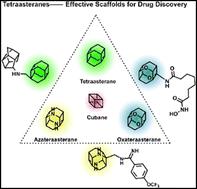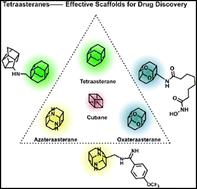作为立方烷同源物的四烷烃:药物发现的有效支架
IF 2.7
3区 化学
Q1 CHEMISTRY, ORGANIC
引用次数: 0
摘要
长期以来,经典的碳氢化合物支架有助于将新分子推向市场,用于多种用途,但其中一个明显的疏忽是四碳烷,它是立方烷的同源物,属于一类多环碳氢化合物笼状化合物。四甾烷具有相同的环丁烷结构和类似立方烷的刚性构象,因此具有作为药物研发支架的潜力。基于密度泛函理论对四元甾烷物理和化学特性的研究,通过用四元甾烷取代药物中的立方烷支架,设计了三个系列的化合物作为立方烷的同系物。通过分子对接和动力学模拟对这些化合物的医药应用潜力进行了硅学评估。通过 ADMET(吸收、分布、代谢、排泄和毒性)分析研究了它们的药代动力学和理化性质。结果表明,四碳烷可以作为立方烷的新型生物异构体支架,也可以作为氢键供体或受体,从而增强配体与受体之间的亲和力,并具有更稳定的结合行为和在 ADMET 中可行的耐受性。所有这些发现为四元甾烷提供了新的机遇,使其成为药物发现的有效药物支架,并通过对新旧商业化合物的再利用,加速药物发现过程。本文章由计算机程序翻译,如有差异,请以英文原文为准。


Tetraasteranes as homologues of cubanes: effective scaffolds for drug discovery†
Classical hydrocarbon scaffolds have long assisted in bringing new molecules to the market for a variety of applications, but one notable omission is that of tetraasteranes, which are homologues of cubanes belonging to a class of polycyclic hydrocarbon cage compounds. Tetraasteranes exhibit potential as scaffolds in drug discovery due to their identical cyclobutane structures and rigid conformation resembling cubanes. Based on the studies of the physical and chemical properties of tetraasteranes by density functional theory, three series of compounds were designed as homologues of cubanes by the substitution of cubane scaffolds in pharmaceuticals with tetraasteranes. Their potential for pharmaceutical applications was evaluated in silico by molecular docking and dynamics simulations. Their pharmacokinetic and physicochemical properties were studied by the ADMET (absorption, distribution, metabolism, excretion, and toxicity) analysis. The results indicate that tetraasteranes may be scaffolds as novel bioisosteres of cubanes, as well as hydrogen bond donors or acceptors, which enhance the affinity between ligands and receptors with more stable binding behavior and feasible tolerability in ADMET. All these findings provide new opportunities for tetraasteranes to serve as effective pharmaceutical scaffolds for drug discovery and to accelerate the drug discovery process by repurposing both new and old commercial compounds.
求助全文
通过发布文献求助,成功后即可免费获取论文全文。
去求助
来源期刊

Organic & Biomolecular Chemistry
化学-有机化学
CiteScore
5.50
自引率
9.40%
发文量
1056
审稿时长
1.3 months
期刊介绍:
Organic & Biomolecular Chemistry is an international journal using integrated research in chemistry-organic chemistry. Founded in 2003 by the Royal Society of Chemistry, the journal is published in Semimonthly issues and has been indexed by SCIE, a leading international database. The journal focuses on the key research and cutting-edge progress in the field of chemistry-organic chemistry, publishes and reports the research results in this field in a timely manner, and is committed to becoming a window and platform for rapid academic exchanges among peers in this field. The journal's impact factor in 2023 is 2.9, and its CiteScore is 5.5.
 求助内容:
求助内容: 应助结果提醒方式:
应助结果提醒方式:


